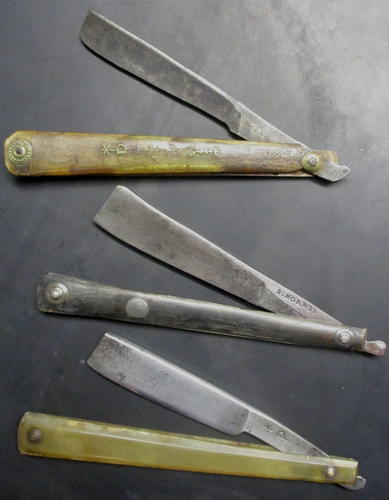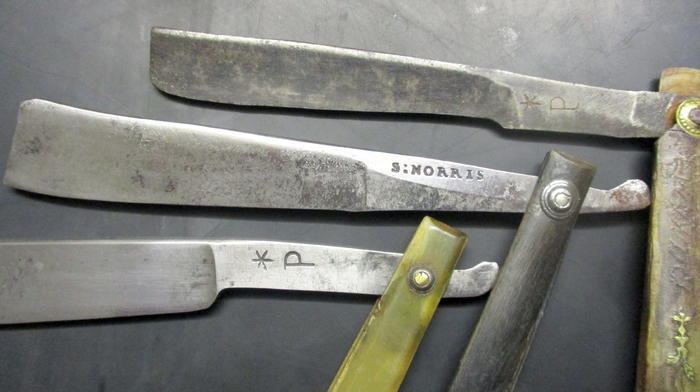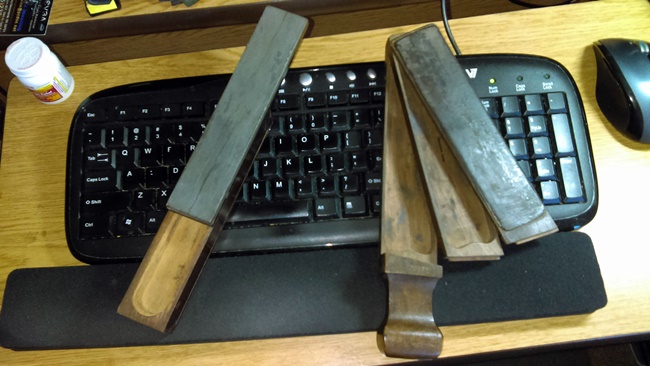Results 81 to 90 of 170
-
10-28-2018, 10:27 PM #81
-
-
10-28-2018, 10:30 PM #82

Fox & Norris, huh? I don’t think I would have ever figured that on my own. Been going in circles for the last 2 hours and hadn’t gotten anywhere.
Thank you ,SG.
-
10-28-2018, 11:03 PM #83

Those boxes are in really nice shape. The leather on this one is pretty much completely gone on the base. Unfortunately the name carved into the handle of the box is nearly illegible. The area I found it in dates back to the late 1800’s and is fairly well documented. I need to take some more pictures of it and fool with exposure settings and see if I can’t actually read it. A rubbing maybe a good way too, I think I’ll try that first.
-
10-28-2018, 11:32 PM #84
-
10-29-2018, 12:04 AM #85
-
10-29-2018, 07:14 AM #86

The Norris are relatively easy to find. A French collector has a collection of 7 copies. He found them all in France. Production must have been important. Your box is french
-
The Following User Says Thank You to lohar For This Useful Post:
Geezer (10-29-2018)
-
10-29-2018, 11:33 AM #87

Nice! Thanks!
The second one is a George Revil https://historyrazors.wordpress.com/...revill-george/
Well done!
-
The Following User Says Thank You to Fikira For This Useful Post:
JOB15 (10-29-2018)
-
10-29-2018, 11:48 AM #88

Actually, a Samuel Norris (1745 - 1817), his parents were Matthew Norris and Catherine Fox.
Catherine Fox was the sister of John Fox, Sheffield, razor-maker (1714 - 1793)
John Fox was one of three brothers, which never married, the mark *P went to Samuel Norris.
Here are 3 razors, the first (with a slight "Dip-at-toe") is a John Fox (see spine). The second
(nice "Dip-at-toe") is a Samuel Norris (not using the *P). The third is a Samuel Norris as well,
using the *P. Since the shape of the razor, it is made around the beginning of the 1800's,
so it must be a Samuel Norris.



Yours is a bit older, it seems to be made around the end of the 18th century - 1800's.
-
The Following 4 Users Say Thank You to Fikira For This Useful Post:
32t (10-29-2018), 782sirbrian (10-31-2018), jfk742 (10-29-2018), MikeT (10-29-2018)
-
10-29-2018, 11:59 AM #89

Your box is marked by the punch of Crenet, Parisian cutler. All the boxes were not marked, but I have already seen. I have a box similar to yours with the punch of Cuvier in Paris.
-
The Following User Says Thank You to lohar For This Useful Post:
jfk742 (10-29-2018)
-
10-29-2018, 12:30 PM #90

Thank you for the description. This helped. I understand the thinking to create a "true" wedge, as this was what I was thinking before, though I didn't realize that there were no true wedges made... except through trial and error, and then it stopped. They stopped trying to make true wedges based on their own experience, and or the experiences of others.
Even with taping the spine, on a "true" wedge, the problem will not be addressed, as the tape folded down leaving the spine edge will contact before the actual spine edge..
This will not fix the rolling problem that the true wedge has.
You can't escape that problem with tape.
IMHO It would be a mistake to take a beautiful piece of history and destroy it, when the experience of others, experience that literally spans centuries, strongly suggests a different approach.
Perhaps you might take a cheap crappy wedge, like I did, and learn the lesson that way.
I will say though, that I wished that I had read this thread before doing that, and I still had a level of guilt for destroying even a scrappy wedge that could have been saved.
To each his own though, and this is simply my limited opinion.“You must unlearn what you have learned.”
– Yoda


 317Likes
317Likes LinkBack URL
LinkBack URL About LinkBacks
About LinkBacks











 Reply With Quote
Reply With Quote
